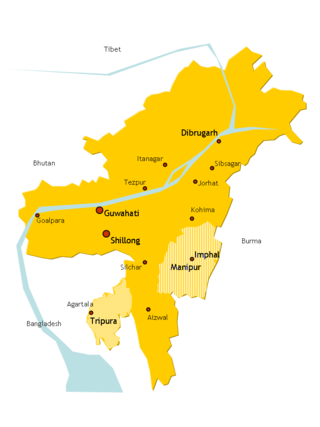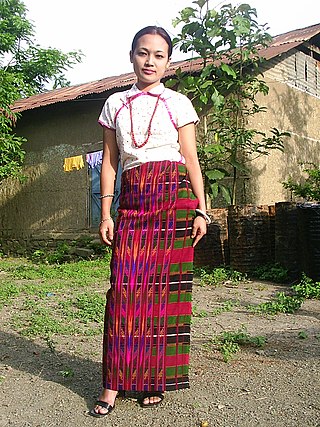Mizo Union was the first political party in Mizoram, northeast India. It was founded on 6 April 1946 at Aizawl as the Mizo Common People's Union. At the time of independence of India from the british rule in india in 1947, the party was the only political force in the Lushai Hills. It won the first Mizoram District Council general election under the new Indian Union in 1951, and consecutively in 1957, 1962 and 1966.

The Mizo people, historically recorded as the Lushais, are an ethnic group native to the state of Mizoram in India and neighbouring states of Northeast India. They speak the Tibeto-Burman language of Mizo, the official language and lingua franca of Mizoram. The state is the second most literate state in India, at more than a rate of 90%.

The Chin people are an ethnic group native to the Chin State and Rakhine State of Myanmar. Strictly speaking, the term "Chin" only refers to the 53 sub-tribes of the Chin ethnic group, divided and recognized by the Burmese government. They speak the Kuki-Chin-Mizo languages, which are often mutually unintelligible but are closely related.
The Paite people are an ethnic group in Northeast India, mainly living in Manipur and Mizoram. The Paites are recognized as a scheduled tribe in these two states. They are part of the Kuki-Zo people, but prefer to use the Zomi identity. "Guite" is a major clan of the Paite people.

The history of Mizoram encompasses the history of Mizoram which lies in the southernmost part of northeast India. It is a conglomerate history of several ethnic groups of Chin people who migrated from Chin State of Burma. But information of their patterns of westward migration are based on oral history and archaeological inferences, hence nothing definite can be said. The recorded history started relatively recently around the mid-19th century when the adjoining regions were occupied by the British monarchy. Following religious, political and cultural revolutions in the mid-20th century majority of the people agglomerated into a super tribe, Mizo. Hence the officially recognised settlement of the Mizos became Mizoram.

The Kuki people are an ethnic group in the Northeastern Indian states of Manipur, Nagaland, Assam, Meghalaya, Tripura and Mizoram, as well as the neighbouring countries of Bangladesh and Myanmar. The Kukis form one of the largest hill tribe communities in Northeast India, along with the adjoining regions of Bangladesh and Myanmar. In Northeast India, they are present in all states except Arunachal Pradesh. The Chin people of Myanmar and the Mizo people of Mizoram are kindred tribes of the Kukis. Collectively, they are termed the Zo people.

The Mizo language is a Tibeto-Burman language spoken mainly in the Indian state of Mizoram, where it is the official language and lingua franca. It is the mother tongue of the Mizo people and some members of the Mizo diaspora. Other than Mizoram, it is also spoken in Meghalaya, Manipur, Tripura, and Assam states of India, Sagaing Region and Chin State in Myanmar, and Chittagong Hill Tracts of Bangladesh. It is mainly based on the Lusei dialect but it has also derived many words from its surrounding Mizo clans.

Tedim (Burmese: တီးတိန်မြို့; MLCTS: ti: tin mrui., pronounced[títeɪ̀ɰ̃mjo̰], (Zo: Tedim Khuapi, pronounced ; is a town and the administrative seat of Tedim Township in Chin State, Myanmar. It is the second largest town in Chin State. The town's four major boroughs are: Sakollam, Myoma, Lawibual and Leilum. The population primarily consists of Chin people.

The Zou people Is are an ethnic group, that is an indigenous community living along the frontier of India and Burma, they are a sub-group of the Kuki people/Zo people. In India, they live with and are similar in language and habits to the Thadou people and Paite and the Simte peoples. In Burma, the Zou are counted among the Chin people. They are a hill people, "Zou" may plainly means "Hills" denoting the Zous are "people of the hills" or "of the hills", and "Zou" has also a different meaning in Zou language that is "complete" or another word for it is "finish". But, the Zou people believed that they incepted the name 'Zou' from their forefather 'Zou' or 'Zo', believed to be the progenitor of the broad Chin-Kuki-Mizo people.

Zo is a Northern Kuki-Chin-Mizo language originating in western Burma and spoken also in Mizoram and Manipur in northeastern India.
Guite is the progenitor clan of Zomi people, also called Chin in Myanmar, Mizo, or Paite, or even Kuki in India. According to Zam, Nigui Guite is the elder brother of the ancestral fathers of the Thadou people, namely Thangpi, Sattawng, and Neirawng. This genealogy is recently in-scripted on the tribal memorial stone at Bungmual, Lamka in the presence of each family-head of the three major clans, Doungel, Kipgen, and Haokip, on August 7, 2011. Some historians, like Shakespeare, assumed Lamlei was the Nigui Guite himself but the Guites themselves recounted Tuahciang, the father of Lamlei, as the son of Nigui Guite instead, in their social-religious rites. Regarding Guite as the born son of Songthu and his sister, Nemnep, it was the practice of ancient royalties to issue royal heir and also to keep their bloodline pure instead. Depending on local pronunciation, the clan was also called differently such as Nguite, Vuite, and was also recorded even as Gwete, Gwite, Nwite,Paihte by the Lushei. In accord with the claim of their solar origin, the Guite clan has been called nampi, meaning noble or major or even dominant people, of the region in local dialect in the past.
The Lai people mainly inhabit the southern parts of Chin Hills in Myanmar's Chin State, in the townships of Falam, Thantlang and Hakha. They are also found in the Lawngtlai district of Mizoram, India, where they have been granted the Lai Autonomous District Council. Outside this area they are scattered in Mizoram and in Manipur. Their languages "Laizo Lai" and "Hakha Lai" are classified as Central Kuki-Chin languages.
The Tedim people, also called Tedim Chins and Tiddim (Hai-Dim) people, are a Zo tribe, part of the Chin people, primarily inhabiting the Tedim Township in the Chin State of Myanmar. They speak the Tedim language, a northern Kuki-Chin language.
The Kuki-Chin languages are a branch of 50 or so Sino-Tibetan languages spoken in northeastern India, western Myanmar and southeastern Bangladesh. Speakers of these languages are Mizo in Mizoram, Kuki people in Manipur, and Chin people in Myanmar.

The Zomi Revolutionary Army is an armed Zomi nationalist insurgent group formed in 1997, following an increase in ethnic tensions between the Kuki people and the Paites tribe in Churachandpur district of Manipur, India. Its parent organisation, the Zomi Revolutionary Organisation, was founded in April 1993.
The Zo people is a term to denote all the speakers of the Kuki-Chin languages who inhabit northeast India, western Myanmar, and southeastern Bangladesh. The Mizo, Chin, and Kuki people are the main ethnic groups.

The Biates are an ethnic hill tribe of Assam, Meghalaya, Mizoram, Tripura and Manipur. Their language belongs to the Tibeto-Burman family. Spread over many parts of North-East India, they have a unique identity with a rich and distinctive history, culture, dialect and religious heritages. They are one of the oldest hill tribes of North East India especially among the Chin-Kuki-Mizo people. The term Biate comes from the word Bia-te. The word ‘Bia’ or ‘Biak’ means ‘speak’ or ‘worship’. ‘Te’ is a suffix denoting plurality. Hence, the two words combine to form the word Biate, which means worshipper.
The Zomi people are one of the main groups of the Zo (Kuki-Chin-Mizo-Zomi) tribes. They live in mostly the India–Myanmar border, as well as in Bangladesh. The Zomis were divided into two by the Indian government as Kuki and the Myanmar government as Chin. The Zomi encompasses the various tribe like Paite, Vaiphei, Zou, Gangte and Simte and the Zomi tribe that is called Chin is the Tiddim/Tedim. They call themselves Zomi and they speak their own language. The Zomi language is basically the language of the Tedim/Tiddim and is related to the Paite language.
Zomi nationalism is an independence movement in Chin State, Myanmar.

Leen Nupa, also spelled Len Nupa, is a valley in Tedim, Chin state, Myanmar. It is also known as Buan Nel.











